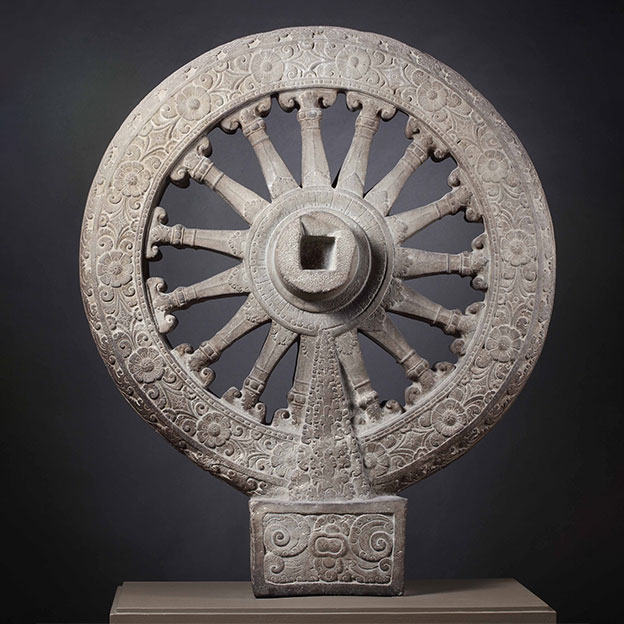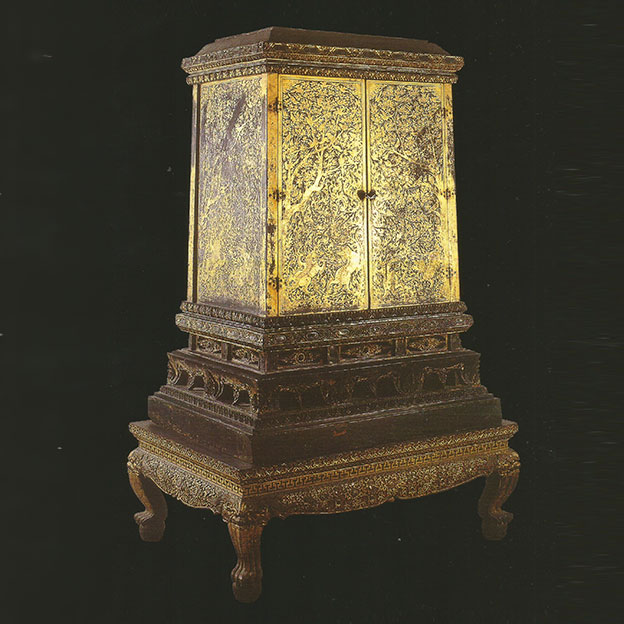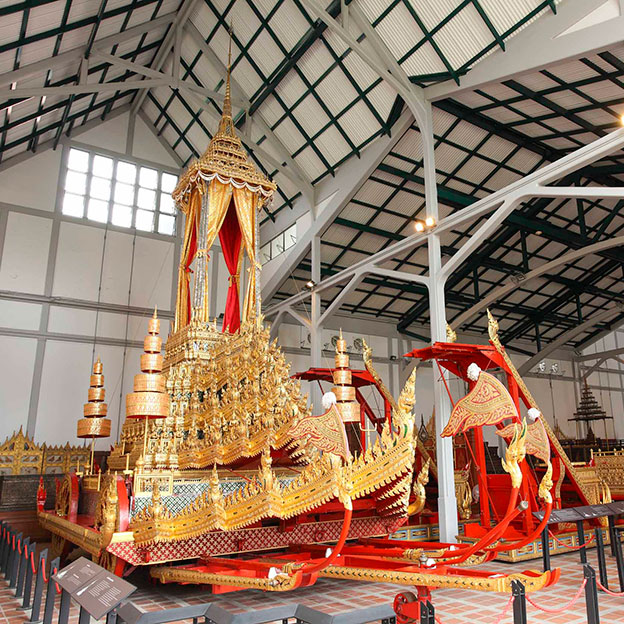

-
Phra Buddha Sihing
Art Style:Lanna, first half of the 16th century
Material:Gilded bronze
Size:Height including pedestal 90 cm Width 63 cm
Provenance:The Prince Successor of King Rama I brought the image from Chiang Mai in 1787 to house in the Sutthasawan Hall (today Buddhaisawan Chapel) of the Palace to the Front (today National Museum Bangkok)
Location:National Museum Bangkok
Description:The image is of the Buddha in meditation, sitting on a lotus pedestal. It was made of bronze and thickly gilded. The face is rather round with a knobbed chin. The eyebrows are curved, the eyes downcast, and the nose is ridged. The hair curls are small, the ushnisha is high with a frame – like finial, and the robe is worn in the open mode, with the robe flap covering the left shoulder.
This is one of the most beautiful and important images in Thailand. Every Songkran (Thai New Year), the image is taken to Sanam Luang to enable people to pay respect to the image.

-
Wheel of Law
Art Style:Dvaravati, 7th – 9th century
Material:Stone
Size:Height 106 cm including pedestal Diameter 88 cm
Provenance:Discovered at abandoned Wat Saneha, Mueang District, Nakhon Pathom Province; Donated by HRH Prince Bhanubandhu Yugala
Location:National Museum Bangkok
Description:This Wheel is carved entirely in the round, and the outer wheel is covered in floral designs. The spokes are similar to ancient Indian columns, with the tops resembling Greco – Roman Corinthian decorations. The spokes are inscribed with Pallava script in the Pali language, and describe Buddhist doctrine. The inner circle consists of lotus petals. The Wheel sits atop a square base carved with floral motifs. In front of the piece is a crouching deer.
The inscription on the hub explains that the Wheel represents the Dhamma, or the teachings of the Buddha – this is evidence that the Wheel of Law was used as a symbol of Buddhism.
The inscription on the spokes describes the Four Noble Truths of Buddhism: 1) Life of suffering; 2) Suffering arises from desires, or thirsts; 3) To eliminate the suffering, we must eliminate the desires; 4) The way to eliminate desires is to follow the Noble Eightfold Path. These Four Noble Truths were introduced by the Buddha during his First Sermon in the Deer Park of Sarnath. This sermon is referred to as “Turning the Wheel of the Law”.
This piece has been listed by the Ministry of Education in legislation dated 24 June 1998 and published in the Government Gazette, Vol. 115, Part 65ng, dated 13 August 1998. The legislation was intended to control the duplication of antiquities and art objects.

-
Manuscript Cabinet
Art Style:Late Ayutthaya, 19th century
Material:Gilded wood
Size:Height 171.8 cm Width 71 cm Length 101 cm
Provenance:Originally at Wat Soengwai, Ayutthaya , but moved to and received from Wat Nangnong, Bang Khunthien, Bangkok
Location:National Museum Bangkok
Description:This large wooden manuscript cabinet is decorated with gold mythical animals from the Himavan Forest, as well as Thai kranok and floral designs. The top and bottom frames are decorated with glass mosaics, and the pedestal is open – work in the form of singha (lion) feet.
This piece was made by the master craftsman of Wat Soengwai, Ayutthaya province, during the late Ayutthaya period of the 19th century. It is an excellent example of religious art, and is regarded as one of the masterpieces of Thai art in general. It was the inspiration for work in the minor arts during the Bangkok period.
The piece has been listed by the Ministry of Education in legislation dated 24 June 1998 and published in the Government Gazette, Vol.115, Part 65ng, dated 13 August 1998. The legislation was intended to control the duplication of antiquities and art objects.

-
Phra Maha Phichai Ratcharot (Royal Chariot of Great Victory)
Art Style:Bangkok, made in 1795 during the reign of King Rama I
Material:Gilded wood with glass mosaics
Size:Height 1,120 cm Length 1,530 cm
Provenance:Built in 1795 for the royal funeral ceremony for the father of King Rama I in 1796, it was used again in 1799 to carry the funeral urn of the King’s eldest sister, Princess Thepsudawadi, to ceremony at the Phra Meru ground, or Sanam Luang; at the same time, the remains of another sister, Princess Sisudarak, were carried in the Wetchayanta Ratcharot to the same funeral ceremony place. Since that time only Phra Maha Pichai Ratcharot has been used for royal funeral ceremonies for the King. After the funeral ceremony for King Chulalongkorn, this royal chariot was broken and another royal chariot, Wetchayanta Ratcharot, was used instead. After the renovation of Phra Maha Pichai Ratcharot by the Fine Arts Department in 1987, it was used for the royal funeral ceremonies of HRH Princess Sri Nagarindra, the Princess Mother, on March 10,1996 and HRH Princess Galyani Vadhana on November 15, 2008.
Location:National Museum Bangkok
Description:This large royal chariot consists of a three-tiered base, with thepanom surrounding each tier, beneath a busabok (“celestial mansion” with four pillars) used to convey the urn with the remains of deceased royalty. A base with four large wheels supports the whole structure, and features a three-headed naga at the front and the tail of the naga in the back. Iron bars at the front and back are used to steer the vehicle. 150 men pull the chariot and 60 men on the back act as brakes.
Wood carving is one of the highest expressions of the Thai minor arts, and this chariot is a masterpiece of the minor arts of the Bangkok royal court. The superb craftmanship and aesthetic value reflect the splendor of Thai culture, and the creativity of the craftsmen illustrates the glory of kingship in Thailand. The skillful design makes the chariot appear light and graceful. In the Thai tradition, the king is considered divine – when he passes away, a royal ceremony must be performed to send him back to heaven, represented by the busabok symbolizes the celestial abode of the gods at the top of the mountain. The chariot and the traditions and culture it represents make this piece very unique.

-
Ivory Howdah
Art Style/Period:Rattanakosin Era, Lanna Craftmanship, 20th Century
Material:Ivory
Size:Height 90 cm Width 71.5 cm Length 173 cm
Provenanc:Phra Chao Intavichayanon presented this ivory howdah to King Chulalongkorn as a gift on his 20th birthday in 1873. The seat was made from carved ivories. The ivory bars of the backrest are crafted in cucumber-like patterns while the inside shows auspicious animals such as lions, peacocks and pheasants amidst floral forest, with human figures in the middle.
Later during the reign of King Rama VII, the howdah was used to carry a Buddha image at the ceremony of mounting the gable finial of the temple of the Emerald buddha.Location:National Museum Bangkok
